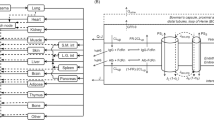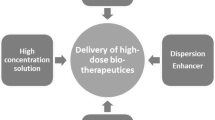Abstract
Purpose: Raltitrexed (Tomudex™), ZD1694) is a novel quinazoline folate analog that selectively inhibits thymidylate synthase. Intracellularly, raltitrexed is polyglutamated to its active form which can be retained in cells for prolonged periods. The pharmacokinetics of raltitrexed in plasma and cerebrospinal fluid (CSF) were studied in a nonhuman primate model. Methods: Animals received 3 mg/m2 (n= 1), 6 mg/m2 (n= 3), or 10 mg/m2 (n= 3) i.v. over 15 min, and frequent plasma samples were obtained over 48 h. CSF samples were drawn from an indwelling 4th ventricular Ommaya reservoir over 48 h. Plasma and CSF raltitrexed concentrations were measured with a novel, sensitive enzyme inhibition assay with a lower limit of quantification of 0.005 μM. A three-compartment pharmacokinetic model was fitted to the raltitrexed plasma concentration-time data. Results: The plasma concentration-time profile of raltitrexed was triexponential with a rapid initial decline and a prolonged terminal elimination phase (t1/2 > 24 h), which was related to retention of raltitrexed in a deep tissue compartment. At the peak approximately 30% of the administered dose was in the deep tissue compartment, and 24 h after the dosing >20% of the administered dose remained in the body with >99% in the deep tissue compartment. The mean peak (end of infusion) plasma concentrations after the 3, 6, and 10 mg/m2 doses were 1.5, 2.4 and 4.8 μM, respectively. The clearance of raltitrexed ranged from 110 to 165 ml/min per m2, and the steady-state volume of distribution exceeded 200 l/m2. The CSF penetration of raltitrexed was limited (0.6 to 2.0%) and drug could only be detected in the CSF following a 10 mg/m2 dose. Conclusions: The elimination of raltitrexed is triexponential with a prolonged terminal elimination phase. The pharmacokinetic profile is consistent with extensive polyglutamation and intracellular retention of ralitrexed. The three-compartment model presented here may be useful for the analysis of the pharmacokinetics of raltitrexed in humans.
Similar content being viewed by others
Author information
Authors and Affiliations
Additional information
Received: 11 January 1999 / Accepted: 10 May 1999
Rights and permissions
About this article
Cite this article
Widemann, B., Balis, F., Godwin, K. et al. The plasma pharmacokinetics and cerebrospinal fluid penetration of the thymidylate synthase inhibitor raltitrexed (TomudexTM) in a nonhuman primate model. Cancer Chemother Pharmacol 44, 439–443 (1999). https://doi.org/10.1007/s002800051116
Issue Date:
DOI: https://doi.org/10.1007/s002800051116




